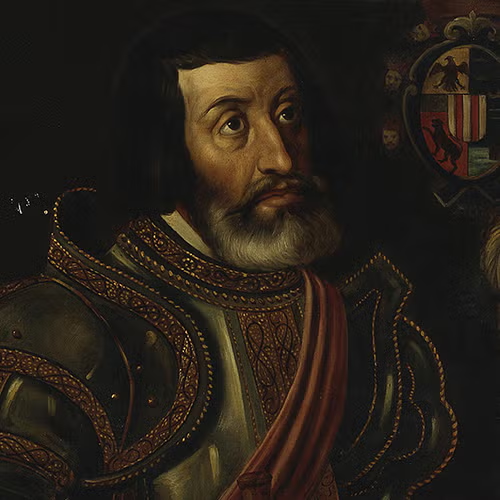
Table of Contents
Who Was Hernán Cortés?
Hernán Cortés, born circa 1485, was a Spanish conquistador whose military prowess and strategic diplomacy led to the conquest of the Aztec Empire and the establishment of Spanish rule in Mexico. At the age of 19, Cortés embarked on his first voyage to the New World, initially joining expeditions to the Caribbean. By 1518, he set off to explore and conquer Mexico, where he skillfully forged alliances with various Indigenous groups, using their support to challenge and eventually defeat the formidable Aztec civilization.
Cortés’ success in overthrowing the Aztec Empire earned him significant recognition. In 1522, King Charles I of Spain rewarded him by appointing him as governor of the newly established New Spain, marking a pivotal moment in the colonization of the Americas.
Early Life of Hernán Cortés, Marqués del Valle de Oaxaca
Hernán Cortés, born around 1485 in Medellín, Spain, hailed from a lesser noble family. Although details of his early education are sparse, some reports suggest that he studied briefly at the University of Salamanca, where he was introduced to law and the humanities.
In 1504, driven by the allure of new opportunities, Cortés left Spain for the New World. He arrived on the island of Hispaniola (modern-day Dominican Republic), settling in the newly established town of Azúa. There, he served as a notary, gaining valuable administrative experience.
In 1511, Cortés joined an expedition to Cuba led by Diego Velázquez de Cuéllar. During his time in Cuba, Cortés rose in prominence, serving in various civil roles, including a period as mayor of Santiago. His time in Cuba set the stage for his later, more ambitious conquests in the Americas.
The Fall of the Aztec Empire
In 1518, Hernán Cortés was appointed to lead an expedition to Mexico. However, before he could embark, the Governor of Cuba, Diego Velázquez, canceled the mission. In defiance of these orders, Cortés set sail for Mexico in 1519 with over 500 men and 11 ships, initiating what would become a momentous chapter in history.
By February of that year, Cortés and his expedition landed on the coast of Mexico. In a bold and decisive move, he allegedly destroyed all but one of his ships, which he sent back to Spain, thereby eliminating any possibility of retreat. This act underscored his determination to conquer the territory.
Cortés skillfully allied with certain Indigenous groups, while others faced brutal military campaigns. He fought battles with the Tlaxcalans and Cholulans before turning his attention to the Aztec Empire. He advanced toward Tenochtitlán, the capital of the empire and home to Emperor Montezuma II. Upon arrival, Cortés was welcomed into the royal palace but soon took Montezuma hostage, using him as leverage while his forces plundered the city.
During this period, Cortés learned that Spanish troops had been dispatched to arrest him for disobeying Governor Velázquez’s orders. Hastily leaving Tenochtitlán, he managed to defeat the arresting force. Upon his return to the Aztec capital, he found the city in rebellion, and Montezuma was killed during the turmoil. Though the Aztecs initially drove the Spanish out of the city, Cortés regrouped and, by 1521, successfully recaptured Tenochtitlán, bringing the mighty Aztec Empire to a violent end.
The conquest was marked by immense bloodshed. It is estimated that as many as 100,000 Indigenous people were killed in the battles that followed. In recognition of his achievements, King Charles I of Spain, later known as Holy Roman Emperor Charles V, appointed Cortés as the governor of New Spain in 1522, cementing his role in shaping the future of the region.
Later Years and Death
Despite his decisive victory over the Aztecs, Hernán Cortés faced significant challenges to his authority in the years following the conquest. Both rivals in the New World and political adversaries in Spain sought to undermine his position. In 1524, he led a campaign to Honduras to suppress a rebellion that threatened his control.
In 1536, Cortés embarked on his final major expedition, exploring northwestern Mexico, including Baja California and the Pacific coast. However, upon returning to Mexico City, he discovered that he had been removed from power. Seeking to restore his influence, Cortés traveled to Spain to appeal directly to the king, but his efforts to regain his governorship were unsuccessful.
By 1541, Cortés had retired to Spain, where he spent his later years striving for recognition of his accomplishments and support from the royal court. Although wealthy, Cortés grew increasingly embittered by the lack of acknowledgment for his contributions. He died in Spain in 1547, leaving behind a legacy marked by both extraordinary achievement and personal disillusionment.
